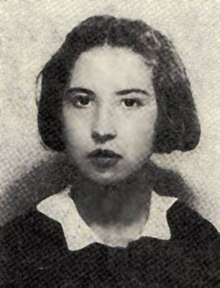Mira Fuchrer
Mira Fuchrer (Hebrew: מירה פוכרר; 1920 – 8 May 1943) was a Polish Jewish activist of the Jewish resistance movement in the Warsaw Ghetto during the occupation of Poland in World War II; member of the Jewish Combat Organization (ŻOB), and fighter in Warsaw Ghetto Uprising of 1943. Surrounded by the Germans and their auxiliaries, she refused to surrender. It is believed that Mira committed suicide in the ghetto bunker with a group of her co-conspirators.[1]
Mira Fuchrer | |
|---|---|
 | |
| Born | 1920 |
| Died | 8 May 1943 (aged 23) Warsaw, General Government |
| Cause of death | KIA |
| Known for | Member of the Jewish Combat Organization (ŻOB), fighter in the Warsaw Ghetto Uprising |
Life
Mira Fuchrer was born in Warsaw. She was active in Hashomer Hatzair youth organisation in the interwar period, which is where she likely met Mordechai Anielewicz. During the Nazi-Soviet invasion of Poland at the onset of World War II, Mira and Mordechai got together, and in September 1939 they fled to Wilno in northeastern part of prewar Poland (now Vilnius, Lithuania).[2] They returned to Warsaw in January 1940, and began transforming Hashomer Hatzair into the resistance movement.[1] In November of the same year, they joined the fate of other Jewish citizens of Warsaw trapped in the newly-formed ghetto.[3]
In the Warsaw Ghetto, Mira worked in a small tailor's shop along with her friends Towa Frenkel and Rachel Zilberberg. In 1942, she visited other ghettos in occupied Poland as a clandestine courier on behalf of ŻOB.[3]
During the Ghetto Uprising, which erupted on 19 April 1943, she fought in the so-called central ghetto. On 8 May 1943, she was in a bunker at 18 Mila Street together with Mordechai Anielewicz, Rachel Zilberberg,[1] and a group of about 120 fighters. When the bunker was discovered and surrounded by the Nazis, the fighters refused to surrender. The majority committed suicide at Arie Wilner's command.[2]
Memorial
Mira Fuchrer's name was engraved on the obelisk set at the steps of the memorial known as Anielewicz Mound in 2006. Her name is listed among the 51 names of fighters whose identities were established by postwar historians.
Notes
- Bartrop, Paul R. (2016). Resisting the Holocaust: Upstanders, Partisans, and Survivors. ABC-CLIO. pp. 11–12. ISBN 1610698797.
- Engelking, Barbara; Leociak, Jacek (2013). Getto warszawskie. Przewodnik po nieistniejącym mieście. Warsaw: Stowarzyszenie Centrum Badań nad Zagładą Żydów. p. 807. ISBN 978-83-63444-27-3.
- Grupińska, Anka (2003). Odczytanie Listy. Kraków: Wydawnictwo Literackie. p. 65. ISBN 83-08-03314-8.
References
- Grupińska, Anka (2000). Ciągle po kole. Rozmowy z żołnierzami getta warszawskiego. Warszawa: Wydawnictwo Twój Styl. p. 381. ISBN 83-7163-187-1.
- Lubetkin, Cywia (1999). Zagłada i powstanie. Warszawa: Wydawnictwo "Książka i Wiedza". p. 172. ISBN 83-05-13041-X.
![]()